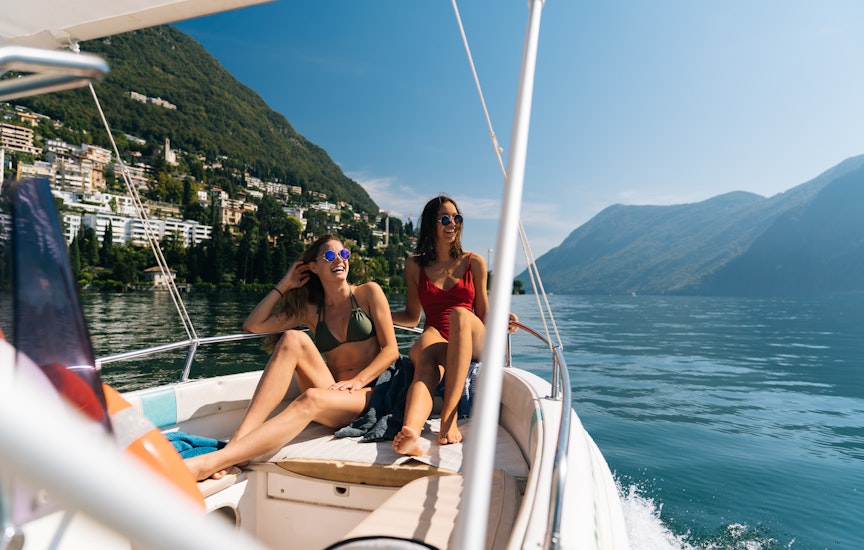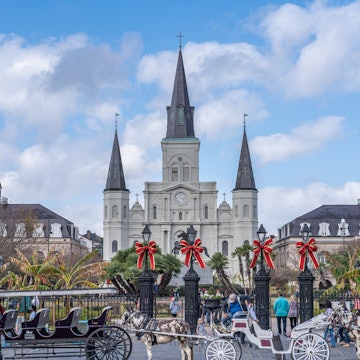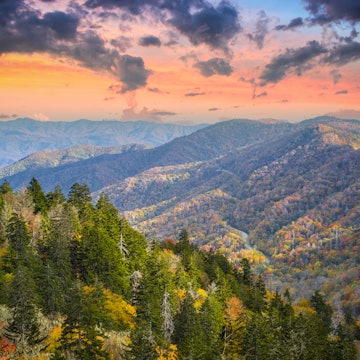

Vineyards in the famous Lavaux aera by lake Geneva in Switzerland. Didier Marti / Getty Images
If ever there was a town to make you want to crack open a bottle of something special, it would be Vevey, reclining smugly on Lake Geneva’s northern shores, with views rippling across glass-blue water to the snow-capped Alps beyond. One glance and you’ll quickly suss out Vevey’s raison d'être: the terraced vineyards that tear up the surrounding slopes give you the first clue (wine, you guessed it) and the giant fork sculpture protruding from the lake alludes to the other (food, ah oui!).
In 2019, Vevey’s pull is greater than ever as the seductive Swiss town gears up to host the Fête des Vignerons, the huge winegrowers’ festival that takes place just once every 20 years, as is tradition. If you’re planning on going, you’d better snag tickets right now.
Celebrating the Fête des Vignerons
Winegrowers (and lovers) come from afar to this mammoth three-week festival, taking place from 18 July to 11 August in 2019. An all-singing, all-dancing ode to bountiful harvests, wine-growing culture and grand cru grapes, this is one of the biggest and oldest festivals of its kind in the world, and it seems everyone is in on the act: from musicians to marching bands, street performers, historic costumed actors, folk dancers and bell-swinging, floral-garlanded cows. Locals are also welcome to join in the revelry as extras.
In its earliest incarnation, the festival harks back to the 17th century, when the Confrérie des Vignerons winegrowers’ association rounded out their assembly with a bit of a do: a parade down to the lake, followed by a small banquet. But in the 18th century it grew swiftly from those humbler origins, with the first big bash held in 1797 to honour the region’s best vintners and their wines. It’s been going strong ever since, and in 2016 the festival was added to Unesco’s list of intangible cultural heritage as a ‘living tradition’.
What’s the draw today? If you’re lucky enough to get tickets, you’re in for a full-on folk fest, with themed parades and performances that nod to the seasons and wine-growing traditions, flag waving, alphorn concerts, choirs and tastings. Each day is given over to a different canton’s pastoral traditions. Performances centre on the main stage of the elliptical auditorium on Place du Marché. It’s a stage as big as an Olympic swimming pool, with space for 20,000 festival-goers. That’s not to mention the wine – get yourself over to the pop-up restaurants and open-door cellars for a rare chance to sample some of the region’s finest Pinot reds and Chasselas whites.

Exploring the Lavaux
If you can’t get festival tickets or you just fancy discovering the region under your own steam at any time of year, the surrounding World Heritage–listed Lavaux vineyards are like heaven on earth to oenophiles. These are the steepest vineyards in the world, terraced over 40 levels and staggering up the hills that rise dramatically above Lake Geneva, with the dreamy lake-and-mountain views you might expect. Never heard of them? That’s because the hand-picked wines are so select, special and small-batch that the Swiss keep most of them to themselves and very few bottles ever reach export.
Before hitting the caveaux (wine cellars) for a petite dégustation (tasting), you’ll want to brush up on local history and wine knowledge. The wine-loving Romans planted the first grapes in the region, but it was Benedictine and Cistercian monks in the 11th century who got down to the serious business of slashing down woodlands in order to plant grapes to slate their thirst for wine. It’s said that these grapes – some of the finest in Switzerland – are blessed by three suns: the one in the sky, the one on the lake and the one radiating heat from the dry-stone walls. As for the grapes themselves, the main one you’ll want to look out for is Chasselas, a very old variety that produces white wines that are crisp and flinty, with a fresh, citrusy nose. The fruity reds (Gamay, Pinot noir and Salvagnin) make up just 20% of production.

You can drive the meandering roads that lope around 40km of shore or take the Lavaux Panoramic Train, but a far better way to get a true feel for the Lavaux is to strike out on foot. Little trails dip into the vines all over the place, but a highly recommended hiking route leads 11km from St-Saphorin to Lutry, where you’ll take in stirring views, pretty villages and welcoming caves (cellars) on your merry way. For a great primer on Lavaux wines, stop off at Vinorama in Rivaz. Housed in a born-again bunker with an ultramodern revamp, the lakefront centre speeds you through the wine-growing process through the seasons, and you can sample dozens of different wines in the Espace Dégustation. For details of other cellars offering wine tastings, check out a handy calendar.
All that tasting might make you hungry, and food-wise you’ve struck gold in the rustic auberges here. You could make for Auberge de la Gare, where season-driven cooking (try the local perch) is paired with Lavaux wines and served on a vine-clad terrace overlooking the lake, or for a brasserie-style ambience, give Auberge de Lavaux in Lutry a shot for its attractive terrace, carefully picked wines and deliciously grilled steaks and seafood.
Eating out in Vevey
Back in the alley-woven centre of Vevey, the indulgence continues. Lake Geneva shines with more Michelin stars than anywhere else in Switzerland, and Vevey is no exception. If you’re up for blowing the budget, where better to do so than at one of the town’s five Michelin-starred restaurants, among them the rather fabulous Denis Martin. The namesake molecular maestro blows minds with his avant-garde spin on a 20-course tasting menu, with mini edible artworks and never-heard-of-before flavours. Upping the game further still, you could venture half an hour west of town to three-Michelin-starred Restaurant de l'Hôtel de Ville in Crissier, headed up by food god Franck Giovannini.
Vevey has plenty of excellent down-to-earth options, too. One of the hottest tables at the moment is Tandem, a stripped-back, retro-cool space taking you through from gourmet brunch to cocktail. The chef takes pride in local sourcing (both ingredients and wines). For more traditional offerings, there’s snug, family-run bistro Le Mazot (good fondue and steaks).
If there’s still space for a little fromage to go with that wine, or if you’d rather skip mains and go straight for cheese, get yourself across to Châtel-St-Denis, 13km northeast of Vevey, for legendary fondue moitié-moitié (made from a combination of Gruyére and Vacherin Fribourgeois cheeses). The two places worthy of note are family-run, ultra-traditional Café Tivoli and more chilled, cafeteria-style La Crémerie, with its adjacent laiterie (dairy).
https://shop.lonelyplanet.com/products/switzerland-travel-guide-9
















